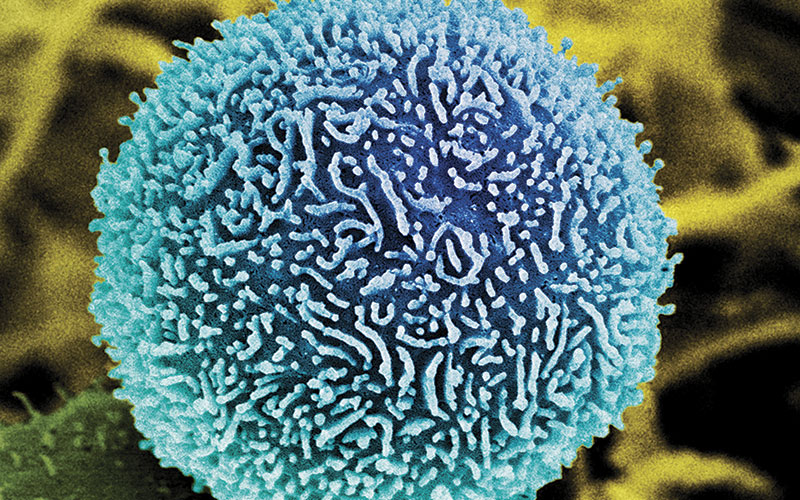The series on tumour markers continues with a brief review of pioneering work in the development, analysis and clinical application of an important serum tumour marker- CA19-9.

CA19-9 tumour marker
The existence of a pancreatic tumour associated antigen was first demonstrated by a research team in Philadelphia, Pennsylvania, led by the noted Polish immunologist Hilary Koprowski in 1981. Although colon cancer was their main interest, by coincidence it was also observed that the antigen was present in patients with pancreas carcinoma. The antigen was characterised by this group combined with a research team led by John Magnani at NIH, Maryland in 1982.
Two monoclonal antibodies 19-9 and 52a were produced by hybridomas obtained from a mouse immunised with human colon carcinoma cell line SW 1116. Separation techniques used included autoradiography, immunostaining of thin layer chromatograms, solid phase radioimmunoassay and GC/MS. The 19-9 antigen was found to be a high molecular weight glycoprotein mucin in serum shed from normal epithelia of the pancreas, gall bladder or gastrointestinal tract but overexpressed in pancreatic cancer and several other malignancies. Interestingly, the mucin also contains the sialylated blood group Lewis-a epitope lacto-N-fucopentaose II. It is estimated that around 6% of Caucasians and 22% of Africans lack the Lewis antigen and are unable to produce CA19-9. It has been proposed that CA19-9 binds an adhesion molecule on vascular epithelia promoting metastasis.
Pancreatic cancer
Around 10,000 people are diagnosed with pancreatic cancer (PC) each year in the UK, with only 21% surviving 12 months and a poor five-year survival rate of just 5%. It is disheartening that there has been no significant improvement in these figures for the last 40 years, despite improvements in surgery, imaging and chemotherapy. It is sometimes called “the silent killer”, due to the lack of specific early clinical symptoms and suitable screening tests for an early diagnosis, and it has been proposed that micro-metastatic invasion precedes tumour formation. This may explain why 80% of patients are diagnosed late, with only 20% eligible for surgery. A total of 95% of patients have ductal adenocarcinoma, with the majority of primary tumours located in neck or head of pancreas. A biopsy taken with endoscopic ultrasound and fine needle aspiration and histology can determine staging and cancer cell type of the four main pancreatic neoplasms, which affects treatment options and likely prognosis. US expert panels in 2016 recommended chemotherapy pre-surgery for operable cases, and for metastatic PC multi-agent chemotherapy or, more recently, multimodality treatment combining cytotoxic agents such as gemcitabine with immunotherapy to harness T cell immunity and reduce inflammation associated with a poor prognosis.
“There is a raised public awareness, with media articles of clinical trials and treatment options”
Serum CA19-9
This is the most studied and clinically useful biomarker for PC, based on the results of numerous clinical trials and their interpretation by meta-analysis data. The university-based research on CA19-9 led to the foundation of Centocor, a biotechnology company that developed a number of immunoassay types commencing with a solid phase radioimmunoassay in 1983. It was claimed the assay was simple to perform, required 0.1ml serum and established a reference range of 0-37units/ml now universally accepted. In a small study of 80 patients with PC, 79% exceeded the upper limit and most had results between 400 and 192,000 units/ml. The studies that followed tended to focus on assay specificity from other pancreatic disorders and the potential for use of CA19-9 in population screening. A study by R Farini and colleagues in 1985 showed serum CA19-9 was able to discriminate PC and chronic pancreatitis, which is the most common confounding diagnosis on presentation. A landmark treatise by W Steinberg in 1990 examined the results of 24 studies and found the assay had a specificity of 90% and sensitivity of 80%, was of value in assessing suitability of patients for resection and help prognosticate survival, and claimed CA19-9 was the “gold standard” marker for PC. However, it was soon recognised that elevated serum results also occur in biliary tract obstruction, inflammatory bowel disease, pancreatitis, cirrhosis of liver and certain other malignancies. CA19-9 has been evaluated in at least two large screening studies of asymptomatic populations, by T Homma and R Tsuchiya in Japan (1991) and JE Kim in South Korea (2004), both concluded that screening was ineffective because of a very low positive predictive value. During the 1990s, improved CA19-9 assays were developed using automated immunoassays with chemiluminescent detection by companies such as Roche, Abbott, and Fujirebio of Japan. The emphasis for clinical value during the last 20 years has been based on CA19-9 in prognosis. N Maisey and colleagues from the Royal Marsden Hospital reported in 2005 that serum CA19-9 was an independent prognostic factor in patients with inoperable PC on systemic chemotherapy (including gemcitabine). A Harvard study a year later by Cristina Ferrone and colleagues claimed that perioperative levels of serum CA19-9 can predict stage and survival in patients with resectable PC. The prognostic and predictive value were confirmed in more recent reports in an Australian study led by JL Humphris in 2012 and in the US by Katherine Poruk in 2013.
Concluding comments
Many alternative biomarkers have been assessed – including CEA, CA50, PAM (anti MUC1) elastase 1 and osteopontin – however, CA19-9 remains superior, despite the limitations described, which appears common to the CA series of markers as illustrated in previous articles on CA125 and CA15-3 and this may be related to their epithelial origin and common structures.
Possible alternatives include genetic micro-array testing, proteome protein profiles and microRNA patterns in pancreatic juice, saliva and blood. There is also a considerable optimistic literature on preventative approaches by identifying risk factors which may damage DNA leading to mutations in PC, including tobacco smoking, diabetes, family history of PC, pancreatitis, obesity, heavy alcohol consumption and several inherited syndromes.
There is a raised public awareness with media articles of clinical trials and treatment options and the deaths due to PC of high profile figures such as Patrick Swayze, Steve Jobs, Luciano Pavarotti and most recently Aretha Franklin.
Stephen Clarke is a retired IBMS Fellow.
Image credit | Getty/Science Photo Library
References
1. Koprowski H, Herlyn M, Steplewski Z et al. Specific antigen in the serum of patients with colon carcinoma Science 1981; 212(4490): 53-55
2. Magnani JL, Nilsson B, Brockhaus M et al. A monoclonal antibody-defined antigen associated with gastrointestinal cancer is a ganglioside containing sialylated lacto-N-fucopentose II. J Biol Chem 1982; 257(23): 14365-14369
3. Diamandis E, Bast R, Gold P, Ming Chu T, Magnani JL Reflection on the discovery of carcinoembryonic antigen, Prostate specific antigen, and cancer antigens CA125 & CA 19-9 Clin Chem 2013; 59(1) : 22-31
4. Magnani JL, Steplewski Z, Koprowski H et al. Identification of a gastrointestinal and pancreatic associated antigen detected by monoclonal antibody 19-9 in the sera of patients as a mucin. Cancer Res 1983; 43: 5489-5492
5. Cancer research UK-2016 incidence, mortality and survival statistics
6. Wolfgang CL, Herman JM, Laheru DA et al. Recent progress in pancreatic cancer. CA Cancer J Clin 2013; 63(5): 318-348
7. Rhim AD, Mirek ET, Aiello NM et al. EMT and dissemination precede pancreatic tumour formation. Cell 2012; 1-2: 349-361
8.Tuveson DA, Neoptolemos JP. Understanding metastasis in pancreatic cancer: a call for new clinical approaches. Cell 2012; 1-2: 21-23
9. Green C Advances in pancreatic cancer: Guidelines, treatment and research. Disclosures June 29th 2017
10. Del Villano BC, Brennan S, Brock P et al. Radioimmunometric assay for a monoclonal antibody defined tumour marker, CA19-9. Clin Chem 1983; 29(3): 549-552
11. Farini R, Fabris C, Bonvicini P et al. CA19-9 in the differential diagnosis between pancreatic cancer and chronic pancreatitis Eur J Cancer and Clin Oncol 1985; 21(4) : 429-432
12. Steinberg W The clinical utility of the CA19-9 tumour associated antigen. Am J Gastroenterol 1990; 85(4): 350-355
13. Poruk KE, Gay DZ, Brown K et al. The clinical utility of CA19-9 in pancreatic adenocarcinoma: diagnostic and prognostic updates Curr Mol Med 2013; 13(3): 340-352




